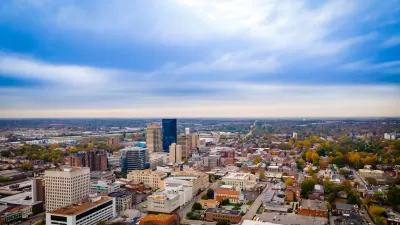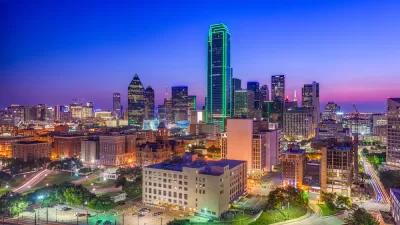After a two-year effort, the City of El Paso adopted a new comprehensive plan this week. Based on smart growth and sustainability principles, author Kaid Benfield calls it "among the best, most articulate comprehensive plans" he's ever seen.
Benfield writes about the process by which Plan El Paso was developed by the city and a consultant team led by Dover, Kohl & Partners, and discusses its key innovations in seeking to control "alarming rates of land consumption and carbon pollution" that are plaguing the country's 19th largest city. A draft of the plan had already received the EPA's award for achievement in smart growth in December, and Benfield thinks the final product had gone even further in its accomplishments.
Quoting from the plan, Benfield points out its key thrust: "The plan proposes strategies to bring more of the activities of daily living within walking distance and a framework of transportation alternatives including transit and bicycle systems. Encouraging walkability helps create healthy life styles. Building complete places that enable neighbors to know each other will help create and retain close-knit communities...The plan revives the idea that additions to the built-environment must be functional and long-lasting but also delightful and attractive. Plan El Paso recognizes that design matters."
To achieve this goal, the plan employs a diversity of tools, many of which take advantage of LEED-ND guidelines. According to Banfield, "the plan gives priority to reinvestment in downtown; transit-supportive infill development; revitalization of older neighborhoods; balanced transportation options; strategic suburban retrofits; sustainable economic development; respect for nature; and much more."
Perhaps most encouraging about the planning process was the substantial public engagement effort involved in the plan's development, which Banfield details. He reports that, "Plan El Paso repeatedly acknowledges that its best ideas were locally generated," which bodes well for its prospects for implementation and perpetuation by citizens and politicians alike.
FULL STORY: It's unanimous: El Paso commits to a smarter, greener future

Americans May Be Stuck — But Why?
Americans are moving a lot less than they once did, and that is a problem. While Yoni Applebaum, in his highly-publicized article Stuck, gets the reasons badly wrong, it's still important to ask: why are we moving so much less than before?

Using Old Oil and Gas Wells for Green Energy Storage
Penn State researchers have found that repurposing abandoned oil and gas wells for geothermal-assisted compressed-air energy storage can boost efficiency, reduce environmental risks, and support clean energy and job transitions.

Placekeeping: Setting a New Precedent for City Planners
How a preservation-based approach to redevelopment and urban design can prevent displacement and honor legacy communities.

San Francisco’s Muni Ridership Grew in 2024
The system saw its highest ridership since before the Covid-19 pandemic, but faces a severe budget shortage in the coming year.

Colorado Lawmakers Move to Protect BRT Funding
In the face of potential federal funding cuts, CDOT leaders reasserted their commitment to planned bus rapid transit projects.

Safe Streets Funding in Jeopardy
The Trump administration is specifically targeting bike infrastructure and other road safety projects in its funding cuts.
Urban Design for Planners 1: Software Tools
This six-course series explores essential urban design concepts using open source software and equips planners with the tools they need to participate fully in the urban design process.
Planning for Universal Design
Learn the tools for implementing Universal Design in planning regulations.
Heyer Gruel & Associates PA
City of Moreno Valley
Institute for Housing and Urban Development Studies (IHS)
City of Grandview
Harvard GSD Executive Education
Salt Lake City
NYU Wagner Graduate School of Public Service
City of Cambridge, Maryland





























